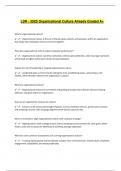LDR - 302S Organizational Culture Already Graded A+
What is organizational culture?
✔️✔️ Organizational culture is the set of shared values, beliefs, and behaviors within an organization
that shape how employees interact and work together.
How does organizational culture impact employee performance?
✔️✔️ Organizational culture can drive motivation, enhance job satisfaction, and encourage teamwork,
which leads to higher performance levels among employees.
Explain the role of leadership in shaping organizational culture.
✔️✔️ Leadership plays a critical role by setting the tone, establishing values, and acting as role
models, which directly influences the organization's culture.
What are organizational values?
✔️✔️ Organizational values are core beliefs and guiding principles that influence decision-making,
behavior, and goals within an organization.
How can an organization measure its culture?
✔️✔️ Culture can be measured through employee surveys, feedback sessions, performance reviews,
and analyzing turnover rates to gauge alignment with desired cultural traits.
Why is it essential to align organizational culture with company strategy?
✔️✔️ Aligning culture with strategy ensures that all employees work towards the same goals, which
fosters unity and increases the likelihood of achieving strategic objectives.
What are some common characteristics of a strong organizational culture?
✔️✔️ A strong organizational culture typically includes clear communication, shared values, employee
engagement, adaptability, and strong leadership.
,What is the difference between formal and informal culture in an organization?
✔️✔️ Formal culture consists of the official rules, policies, and hierarchy, while informal culture
includes unwritten norms, social interactions, and relationships among employees.
How does an organization's culture evolve over time?
✔️✔️ Culture evolves due to factors like leadership changes, company growth, external influences,
and employee turnover, which can shift values and norms over time.
Describe the role of onboarding in establishing organizational culture.
✔️✔️ Onboarding introduces new employees to the company’s values, expectations, and work
environment, helping them integrate and adapt to the organizational culture quickly.
Why might an organization choose to change its culture?
✔️✔️ Organizations may change culture to improve performance, address employee dissatisfaction,
adapt to industry shifts, or better align with evolving goals and values.
How can diversity influence organizational culture?
✔️✔️ Diversity can enrich culture by bringing in varied perspectives, fostering creativity, enhancing
problem-solving, and promoting inclusiveness within the organization.
What is cultural fit, and why is it important in hiring?
✔️✔️ Cultural fit is the alignment between a candidate’s values and the organization’s culture. It is
important because it can lead to higher job satisfaction and lower turnover.
Explain the concept of “adaptive culture.”
✔️✔️ An adaptive culture is one that readily embraces change, encourages innovation, and allows the
organization to respond effectively to shifts in the market or industry.
How can organizational culture affect customer satisfaction?
, ✔️✔️ A positive culture encourages employees to deliver excellent service, which can lead to greater
customer satisfaction and loyalty.
What is the role of communication in maintaining a healthy organizational culture?
✔️✔️ Open and transparent communication fosters trust, aligns employees with organizational goals,
and supports a collaborative environment.
Changing organizational systems and procedures BEST describes which of the following embedding
mechanisms, which serve as the conscious and subconscious ways of forming organization culture?
Transform the culture
In an article by Chaplain Kenneth R. Williams, he used a formulaic model to calculate the approximate
monetary costs of toxic behavior in an organization. The formula calculated costs for worrying, physical
and mental health, absenteeism, avoidance, and conversations with co-workers. Which of the five
effects of toxic leadership measured caused the LEAST financial impact for the organization?
Cost of absenteeism
Treating each individual with dignity and fairness, with the operational premise that you treat others in
concert with the way you would like to be treated BEST defines which of the following?
Respectful engagement
Toxicity
pattern of combined, counterproductive behaviors
encompassing not only harmful leadership but also abusive supervision, bullying, and workplace
incivility, involving
leaders, peers, and direct reports as offenders, incorporating six specific behaviors (see table):
Behaviors:
1. shaming
2. passive
3. hostility
4. team sabotage
5. indifference negativity
6. exploitation




